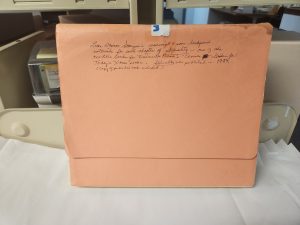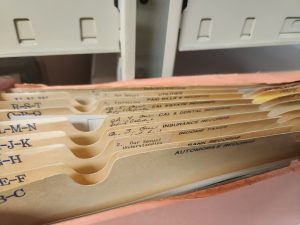In 2016, two important events occurred: 1) Letha Dawson Scanzoni donated her personal collection of her own writings, research, and activist materials for the Archive of Women in Theological Scholarship and 2) a library staff member ordered a megaphone.
Fast forward to the first day of my Graduate Internship in Primary Sources, June 2023. This is my first time processing a collection. I’ve been preparing for papers in chaos, mold, and insects. But the first box I open, confusingly, contains a megaphone. A seemingly unopened megaphone.
The accessioning record states that ten boxes, including nine unmarked shipping boxes and one record crate, were placed aside for later processing the day they arrived at Burke on March 30, 2016. On the day of delivery, the megaphone must have been grouped in with the load of unmarked brown shipping boxes used by Scanzoni to send her life’s work to the library.
Letha Dawson Scanzoni is a feminist Chrsitian activist, writer, and founding member of the Evangelical and Ecumenical Women’s Caucus. So naturally, my first thought was that this megaphone was a cool piece of material culture, maybe used in their fight to support the ERA or a demonstration for LGBTQ+ rights! But, this was clearly a brand new megaphone, still taped into its factory box. Inside the shipping box I found an Amazon receipt charging $30 to a library staff member. Unfortunately for this collection, the megaphone has been formally deaccessioned (a necessary step in any processing plan) and rehoused in a closet, another kind of archive in a way, with fonds of mops and replacement light bulbs. The megaphone box was on theme, but didn’t have the right provenance for this collection.
Luckily, that wasn’t the only cool item in Scanzoni’s papers. Since the megaphone incident, I’ve also encountered one of the oldest floppy disks I’ve ever seen (it fits exactly one jpeg image), an interesting auto repair accordion folder repurposed for book research, and a bespoke “Thank You Scroll” created by Evangelical and Ecumenical Women’s Caucus members to show gratitude to Scanzoni for her work organizing their 1980 Conference.
While the floppy disk demonstrates a particular snapshot of tech history, the accordion binder and scroll are bespoke items that flesh out aspects of Scanzoni’s life, work, and community.
The accordion binder containing research for her 1984 book Sexuality, full of library Xerox copies and clippings, gives us a peek into Scanzoni’s research process. Her use of repurposed materials allows us to imagine the resourcefulness of a newly single mother writing independent of the university setting. The chapter-based organization shows the way she imagined the book and its contents before it was censored and edited by Westminster Press, who she later went on to fight for book rights after they quickly placed the book out of print in the early 1990s.


The “Thank You” Scroll is a heartwarming peek into the strong Christian feminist community that Scanzoni was a part of. Letters in the collection note that there were some negative feelings and animosity created at the 1980 conference that Scanzoni organized. Taking these letters into account with her narrative in the biography Building Bridges: Letha Dawson Scanzoni and Friends, the conflict was likely the emerging factionalization in the organization around lesbian inclusion and gay rights. The scroll, created at a Seattle chapter gathering, demonstrates the support that Scanzoni had in bringing lesbian and gay issues to the forefront of EWC’s platform and the importance of the conference to EWC members.
As a material object, the scroll is an example of the craft tradition of Christian women, rooted in the repurposing of household materials for other uses and the meaning that creating makes. A letter might have been easier (certainly it would have been easier to store. I don’t know how we’re going to make this 100+ foot scroll accessible to researchers), but the fact that each gathered member wrote their own message of faith and support in their own hand, the pretty green checkerboard pattern that brings to mind the picnic it was created at, and the lovingly tied fastener of neon green craft yarn lend these messages personality and a quality of friendship that is more difficult to see in a letter or email.
In sum, while I wanted the megaphone to be important, it was just a purchased object. The most interesting and meaningful items in the collection turned out to be crafted and bespoke, showing the material culture, resources, and personality of Scanzoni and her community. -KH
About the author:
Kit Hermanson (they/them) is a PhD candidate in Columbia University’s Department of Religion whose work looks at non-binary gender expression in the American 19th century. The Graduate Internship in Primary Sources has furthered their interest in how historical narratives construct queer and trans lives across time, politics, and terminology.